The Battle of Pritzlawa (Prinzlowa) in 1056 took place near present Quitzöbel between the Saxons and the Slavic Liutizen. The battle was a disaster for the Saxons, killing many knights and their leader William, Margrave of the Nordmark.
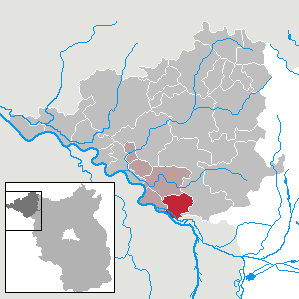
Legde/Quitzöbel is a municipality in the Prignitz district, in Brandenburg, Germany.
William was the Margrave of the Nordmark from 1051 until his death. He was the eldest son and successor of the Margrave Bernard by a daughter of Vladimir the Great. He died fighting the Slavs in the Battle of Pritzlawa. Upon his death, he was succeeded by his half-brother Otto as Margrave of the Nordmark.
Pritzlawa first appears as iuxta Wiribeni Albim in the Chronicle of Thietmar of Merseburg. He reported that Emperor Henry II met there several times with Poles, resulting more often than not in war rather than peace.
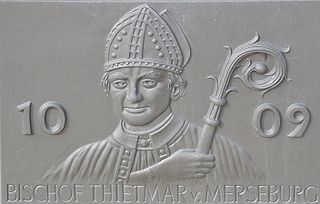
Thietmar, Prince-Bishop of Merseburg from 1009 until his death, was an important chronicler recording the reigns of German kings and Holy Roman Emperors of the Ottonian (Saxon) dynasty. Two of Thietmar's great-grandfathers, both referred to Liuthar, were the Saxon nobles Lothar II, Count of Stade, and Lothar I, Count of Walbeck. They were both killed fighting the Slavs at the Battle of Lenzen.
After their defeat during the Great Slav Rising of 983, the Germans were anxious to recover their old rule. The peace imposed by Emperor Conrad II was twice broken under the rule of Henry III. In 1045, he led an expedition and they quickly submitted, returning to pay tribute. After ten years of negotiation the Liutizen again rose up and the emperor dispatched William of the Nordmark and a Count Dietrich (it is unclear as to who this count was) with a large force to rein them in. In 1056, the Saxons made their move to disastrous results. Led by Margrave William, he and his knights and horsemen drowned in the flooding of the Havel. Both William and Dietrich fell in this battle, where a ruined castle still overlooks the confluence of the Havel and the Elbe. (The number of knights lost has been estimated in the thousands, which is doubtful.) The news of this defeat apparently seriously impacted the seriously ill Emperor Henry III, possibly hastening his death. The result of the battle was inconclusive, with the Poles turning to internal affairs under Casimir I the Restorer.

The Great Slav Rising in 983 was an uprising of the Polabian Slavs (Wends), mainly Lutici and Obotrite tribes living east of the Elbe River in modern north-east Germany. They were revolting against Christianization and their subjugation to the German realm of the Holy Roman Emperor.
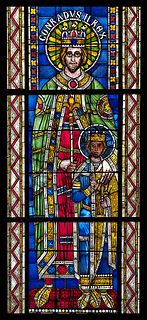
Conrad II, also known as Conrad the Elder and Conrad the Salic, was Emperor of the Holy Roman Empire from 1027 until his death in 1039. The founder of the Salian dynasty of emperors, Conrad also served as King of Germany from 1024, King of Italy from 1026, and King of Burgundy from 1033.

Henry III, called the Black or the Pious, was a member of the Salian Dynasty of Holy Roman Emperors. He was the eldest son of Conrad II of Germany and Gisela of Swabia. His father made him Duke of Bavaria in 1026, after the death of Duke Henry V.

The Northern March or North March was created out of the division of the vast Marca Geronis in 965. It initially comprised the northern third of the Marca and was part of the territorial organisation of areas conquered from the Wends. A Lutician rebellion in 983 reversed German control over the region until the establishment of the March of Brandenburg by Albert the Bear in the 12th century.
Rikdag, also called Ricdag, Riddag, or Rihdag, was Margrave of Meissen from 979 until his death. In 982, he also acquired the marches of Merseburg and Zeitz. After the Great Slav Rising in 983, he temporarily reunited all of the southern marca Geronis under his command. His march included the territory of the Chutizi and Dolomici tribes.
Eckard I was Margrave of Meissen from 985 until his death. He was the first margrave of the Ekkehardinger family that ruled over Meissen until the extinction of the line in 1046.
Dietrich of Haldensleben was a Saxon count in the Schwabengau, later also in the Nordthüringgau and the Derlingau, who was the first Margrave of the Northern March from 965 until the Great Slav Rising of 983. He also bore the title of a dux (duke) in contemporary sources.
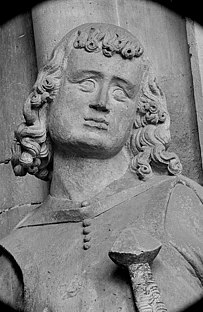
Herman I was Margrave of Meissen from 1009 until his death.
Lothair I was Margrave of the Nordmark from about 983 until his death. He was also a member of Saxon nobility as Count of Derlingau and of Nordthüringgau.
Bernard was the Margrave of the Nordmark from 1009 until his death. He was the son of Dietrich of Haldensleben and a rival of the counts of Walbeck, one of whom, Werner, he succeeded in the march following his deposition.
Dedo I, Count of Wettin, also known as Dedo I of Wettin, was a son of Theodoric I of Wettin and Jutta of Merseburg.
The Battle of Lenzen was a land battle between a Saxon army of the Kingdom of Germany and the armies of the Slavic Redarii and Linonen peoples, that took place on 4 September 929 near the fortified Linonen stronghold of Lenzen in Brandenburg, Germany. The Saxon army, commanded by Saxon magnate Bernhard, destroyed a Slavic Redarii army. It marked the failure of Slavic attempts to resist German king Henry I's expansionism to the Elbe.
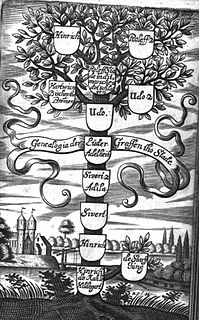
The Counts of Stade were members of the Saxony nobility beginning in the 10th century. Stade had developed since the 8th century as a principal center of trade and communications. The Counts of Stade created their domain between the lower Elbe and Weser rivers. They extended their power northwards with the acquisition of Dithmarschen in the 11th century. They became the Margraves of the Nordmark in 1056. There is also a close political and familial relationship between the Counts of Stade and the Counts of Walbeck. The county of Stade and Northern March were replaced by the March of Brandenburg by Henry the Lion, Duke of Saxony, in the 12th century. The family of Counts of Stade is referred to as the House of Udonids.
Henry I the Bald was Count of Stade. He was son of Lothar II, Count of Stade, and Swanhild of Saxony. Henry is recorded as a cousin of Otto I, Holy Roman Emperor, but their exact relationship remains a mystery. Henry was also appointed Count of Heilangau, the ancient capital of Stade, in 959.

The Counts of Walbeck ruled a medieval territory with its capital Walbeck northeast of Helmstedt in the present town Oebisfelde-Weferlingen in Saxony-Anhalt. The foundation of the Archbishopric of Magdeburg established the region as firmly in the oversight of Otto the Great, Holy Roman Emperor. The first Count of Walbeck, Lothar I, was great-grandfather of Thietmar, Prince-Bishop of Merseburg, chronicler of the Ottonian dynasty of Germany and the Holy Roman Empire. Two of Thietmar’s great-grandfathers, both named Lothar, were killed in the Battle of Lenzen, pitting the forces of Henry the Fowler against the Slavs. The early Margraves of the Nordmark were descended from the House of Walbeck.
Lothair Udo I, Count of Stade, son of Henry I the Bald, Count of Stade, and his wife Judith von der Wetterau, granddaughter of Gebhard, Duke of Lorraine. Lothair is frequently confused with his nephew Lothair Udo II, son of his brother Siegfried II, who was Margrave of Nordmark as Lothair Udo I.
Siegfried II (956-1037), Count of Stade, youngest son of Henry I the Bald, Count of Stade, and his wife Judith von der Wetterau, granddaughter of Gebhard, Duke of Lorraine.
Lothar II the Elder, Count of Walbeck, son of Lothar I, Count of Walbeck.
Lothair Udo I, Margrave of Nordmark and Count of Stade, son of Siegfried II, Count of Stade, and Adela of Rhienfelden, daughter of Gero, Count of Alsleben. Lothair was the first of the House of Udonids to serve as margrave.
Siegfried I the Older, Count of Walbeck and Möckerngau, son of Lothar II the Old, Count of Walbeck, and Mathilde von Arneburg. He succeeded his father as Count of Walbeck upon his death.
The Udonids (Udonen) were a German noble family, ruling as both the Counts of Stade and Margraves of the Nordmark, or Northern March, from the 9th to the 12th century. The first formal member of this family was Henry I the Bald, who took his seat in Harsefeld, part of the Duchy of Franconia, where he built a castle in 965. He was the grandson of the first Count of Stade, Lothar I, who was killed by the Great Heathen Army in the Battle of Ebstorf, and was recognized as one of the Martyrs of Ebsdorf by the Catholic Church.
Gero, Count of Alsleben, conjectured to be the son of Siegfried and therefore grandson of Gero the Great. If so, his mother was Hedwig, daughter of Wichmann the Elder. Gero was the brother of Tetta, who established a monastery at Alsleben in his name. Thietmar of Merseburg, whose Chronicon is the major source of information here, refers to Gero as a Count in Northern Thuringia and Morzani.








